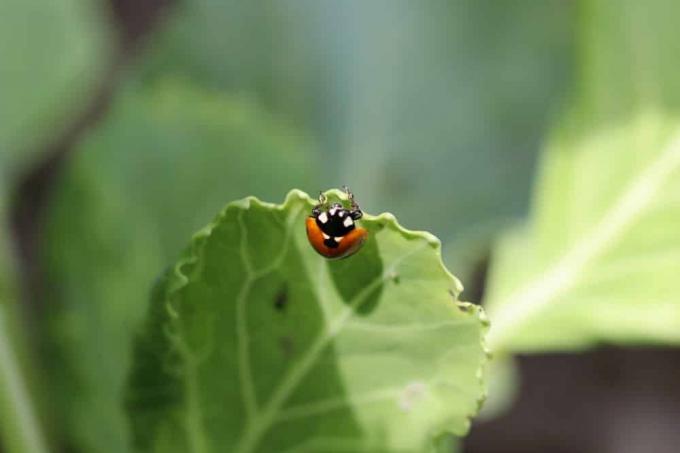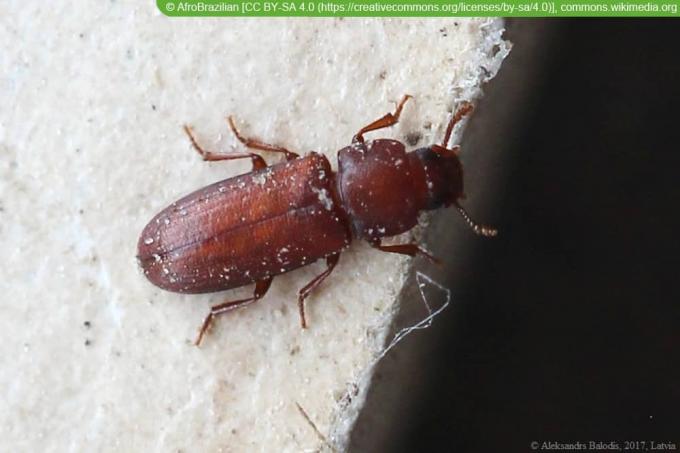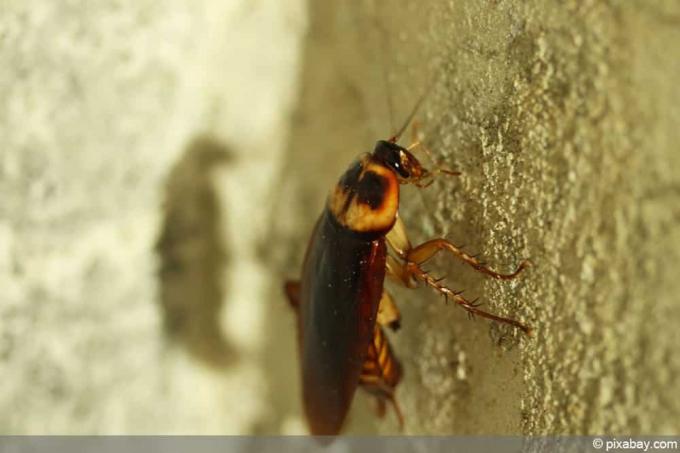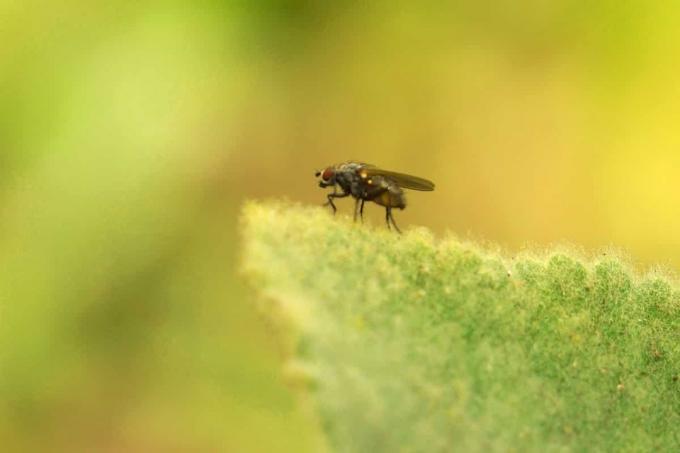

siga, Stegobium paniceum side, edited by Hausgarten, CC BY-SA 3.0
siga, Stegobium paniceum front, edited by Hausgarten, CC BY-SA 3.0
siga, Stegobium paniceum under, edited by Hausgarten, CC BY-SA 3.0
Table of contents
- Overwintering guests in the house
- American pine bug (Leptoglossus occidentalis)
- Carpet beetle (Anthrenus/Anthrenocerus)
- Ladybird (Coccinella)
- bugs on food
- American flour flour beetle (Tribolium confusum)
- Hairy sponge beetle (Typhaea stercorea)
- Bacon Beetle (Dermestes)
- Edible bean weevil (Acanthoscelides obtectus)
- cockroach
- Living space building fabric and furnishings
- Weevil (Stereocorynes truncorum)
- Furniture cockroach (Supella longipalpa)
- House Longhorn (Hylotrupes bajulus)
One or the other beetle can be found in every house. These are mostly beetles that are specifically looking for human supplies that serve as a source of food for them. They often live exclusively indoors and can quickly become a problem. There are only a few exceptions, because beneficial insects such as ladybugs also use indoor spaces for hibernation.
Overwintering guests in the house
Warm interiors serve many insects as a shelter for hibernation. These are not always useful insects and occasionally they are pests. These do not necessarily have to be on or cause damage indoors, but because of their retreats they can breed better and do more damage when it is warm.
American pine bug (Leptoglossus occidentalis)

Although the American pine bug is a forest pest, it is often found indoors, especially where the roof truss is made of softwood. Although roof trusses are not in danger from the pine bugs, there are various conifers that serve as a source of food as soon as it gets warmer.
Identifying features:
- widened lower legs
- 15-20mm long
- quadruple antennae
- reddish brown with black or white color components
- typical zigzag line on the forewings
- Defense secretion smelling of apple or lemon
Carpet beetle (Anthrenus/Anthrenocerus)

There are several species of carpet beetle, some of which have been introduced. The pattern of the elytra with zigzag lines is typical for the beetles. The beetle actually feeds on nectar and pollen, but the larvae hibernate indoors, which are cool. There they feed on various animal products such as wool or down pillows. Since many carpets used to be made of sheep's wool and were found food for them, it also gave them the name carpet beetle.
Ladybird (Coccinella)

In autumn, ladybugs often get lost in the house. They often nest in large numbers in the area of door frames.
Identifying features:
- between 2 and 24 points
- yellow, orange, red or black coloring
- up to 12 mm long
- oval body shape
- long antennae with club-shaped swellings at the end
Interiors are only emergency quarters for the ladybug and are usually not suitable. Due to the increase in temperature during the heating period, they are taken out of their hibernation too early and they usually do not find suitable food indoors. Ladybugs should therefore be relocated to frost-free places with constant temperatures around 10°C.
Tip:
To relocate, fix a nylon stocking with a rubber band at the end of the vacuum cleaner tube. The beetles can then be carefully sucked into the stocking at the lowest level and released again in a suitable place.
bugs on food
Bugs that feed on food are particularly problematic. They often go undetected for a long time, giving them the chance to reproduce undisturbed. This is often associated with a health risk. Some food pests can act as intermediate hosts. They can transmit bacteria, germs and viruses through contact with food or through their excrements and excrete worm eggs in the faeces, which humans use as hosts.
For this reason, certain beetles in food are notifiable. An infestation is reported to the responsible health authority. In private premises, the respective owner is responsible for combating and also bears the costs for this. If an infestation is reported to the office by a third party, it may happen that the competent authority orders control at its own expense.
American flour flour beetle (Tribolium confusum)

The American flour beetle is a brown beetle about four millimeters long that originally comes from America. It was originally brought to Europe with grain and, what its name suggests, not only affects rice. It can be found in all types of grain and is one of those beetles that are considered particularly dangerous in the home. The beetles can leave behind so-called quinones when they come into contact with food, which is said to have a carcinogenic effect.
Tip:
Tip: Dispose of food that has been infested by the flour beetle immediately and do not use it as animal feed.
Hairy sponge beetle (Typhaea stercorea)

The hairy sponge beetle is actually a secondary pest that only appears when food has already been damaged in some other way. The tree fungus beetle prefers foods infested with mold, which it in turn feeds on. It is an indirect carrier of salmonella, which is why affected food should be destroyed immediately.
Bacon Beetle (Dermestes)

André Karwath aka Aka, Dermestes lardarius – top (aka), edited by Hausgarten, CC BY-SA 2.5.
Bacon beetles are one of the most common house bugs in Germany. There are numerous species, some of them introduced by food transport. It is typical of the bacon beetle that it mainly eats animal products such as meat and sausage products, but other foods are also on its menu.
Overview of endangered foods
- bacon
- Ham
- Cheese
- dried pasta with egg
- dried meat
- Dried fish including feed such as fishmeal
- dry dog and cat food
Edible bean weevil (Acanthoscelides obtectus)

The edible bean weevil is one of the few food pests that specialize in a specific food group: beans. In rare cases, they also attack chickpeas or soybeans, but this is rather an exception.
cockroach
The cockroach is the most common reportable hygiene pest in food processing facilities, but it always occurs more often in private rooms, because even small amounts of food are enough for her, unpackaged under a cupboard, for example slide. In addition, the ever warmer temperatures favor their spread.

There are usually three different types of cockroaches referred to as cockroaches:
- German cockroach (Blattella germanica)
- common cockroach (Blatta orientalis)
- American cockroach (Periplaneta americana)
Living space building fabric and furnishings
Walls and beams also provide habitat for some bugs. In this case, however, it is usually an alarm signal that should be taken seriously, because they would not nest if the building fabric was not already damaged, for example by moisture or mold.
Weevil (Stereocorynes truncorum)

The bar weevil is a beetle up to three millimeters long that has a typical downwardly elongated head that looks like a snout. It is a secondary pest that settles in built-up wood that has been damaged by fungal infestation.
Furniture cockroach (Supella longipalpa)
The furniture cockroach is easy to recognize because it is about 1 cm long and has a dark brown color with two lighter horizontal stripes. The furniture cockroach is listed in the German Infection Protection Act because it is considered harmful and can transmit diseases to humans. It not only affects furniture, but also penetrates electrical devices such as PCs and can cause malfunctions there.
House Longhorn (Hylotrupes bajulus)

The house borer is better known under the name woodworm, because it prefers to inhabit coniferous wood that is not impregnated. Therefore, roof beams are particularly at risk, as they can cause massive damage.
identifying features
- brown-black coloring
- 16-25mm long
- Larva white to beige
- typical rasping feeding noise of the larvae
- characteristic holes in the wood (possibly wood flour on the floor)
 Home editorial office
Home editorial office
Learn more about home pests

Drive away cockroaches: leave the light on at night?
Cockroaches are among the most disgusting pests that can appear in living spaces. But the disgust factor is only one side of the coin. The other is that the crawlies contaminate food supplies with pathogens. It is therefore essential to declare war on insects. Can cockroaches be repelled by leaving the light on at night?

Spotting mites in bed: 9 signs of bed mites
Mites are found everywhere in the home. Even in a clean, well-groomed bed, millions of animals can be found. This is not only a problem for allergy sufferers, but can also cause allergies.

Identify cockroaches: what do cockroaches look like?
Cockroaches are disgusting, everyone agrees on that. Worse still, they nibble at our food supplies and leave behind disease-causing germs. Because cockroaches flee and hide at lightning speed, we rarely see them. But then everyone should recognize them immediately.

Electric spider in the house: how to get rid of it
A thin body and long, thin legs characterize the electric spider. It got its name because it trembles when touched. The insect likes to stay indoors. Read how to banish the unwanted guest from your apartment.

Caution hantavirus: properly remove mouse droppings
Anyone who lives in the country, maybe keeps animals or who is often out and about in the forest is at risk from so-called hantaviruses. These are transmitted by mice and their droppings, so you should take extra precautions when removing them.

Fight houseflies: 10 remedies & tips
The housefly can be fought with various traps that have been prepared with attractants. Adhesive surfaces or liquids ensure that the insects can no longer escape. In addition, there are simple measures to keep the annoying flies out of the apartment.

